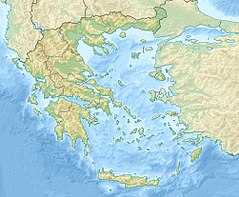| Grave Stele of Dexileos | |
|---|---|
 Athenian cavalryman Dexileos fighting a naked Peloponnesian hoplite in the Corinthian War.[1] Dexileos was killed in action near Corinth in the summer of 394 BC, probably in the Battle of Nemea,[1] or in a proximate engagement.[2] Grave Stele of Dexileos, 394–393 BC. | |
| Material | Pentelic marble |
| Size | 1.86 metres (6 ft 1 in) tall |
| Writing | Epitaph in Greek |
| Created | Circa 394 BC |
| Discovered | 1863 |
| Present location | Dipylon cemetery, Kerameikos, Athens, Greece |
The Grave Stele of Dexileos is the stele of the tomb of an Athenian cavalryman named Dexileos (Ancient Greek: Δεξίλεως) who died in the Corinthian War against Sparta in 394 BC. The stele is attributed to "The Dexileos Sculptor". Its creation can be dated to 394 BC, based on the inscription on its bottom, which provides the dates of birth and death of Dexileos.[3] The stele is made out of an expensive variety of Pentelic marble and is 1.86 metres (6 ft 1 in) tall. It includes a high relief sculpture depicting a battle scene with an inscription below it. The stele was discovered in 1863 in the family plot of Dexileos at the Dipylon cemetery in the Kerameikos cemetery of Athens. It was found in situ, but moved during World War II, and is now on display in the Kerameikos Museum in Athens.[4]
- ^ a b Hutchinson, Godfrey (2014). Sparta: Unfit for Empire. Frontline Books. p. 43. ISBN 9781848322226.
- ^ "IGII2 6217 Epitaph of Dexileos, cavalryman killed in Corinthian war (394 BC)". www.atticinscriptions.com.
- ^ "Kerameikos P 1130 (Sculpture)". www.perseus.tufts.edu.
- ^ "The Dexileos Stele: A Study of Aristocracy and Democracy in Greek Art". World History Encyclopedia.
